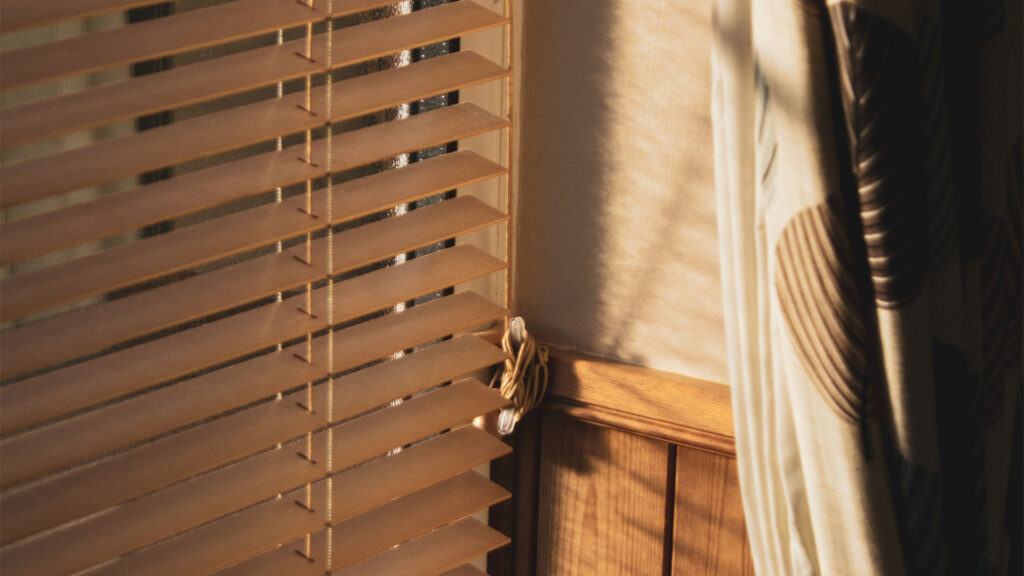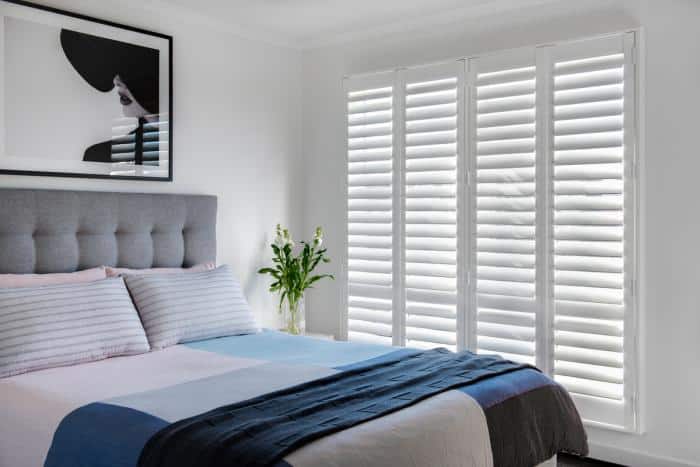
Energy Efficiency of Blinds and Shutters
Blinds and shutters offer substantial environmental and financial advantages when it comes to energy efficiency. These window coverings serve as an efficient insulator, which helps to control indoor temperature and lessen reliance on heating and cooling systems. Blinds and shutters can reduce the demand for artificial lighting during the day by effectively regulating the quantity of sunlight that enters a room.
Additionally, because of the ability to alter the blade angles provided by their slatted construction, these windows maximise natural ventilation while requiring less air conditioning. These actions not only result in significant energy cost reductions but also a reduction in energy usage and related glasshouse gas emissions. Additionally, certain blinds and shutters are made expressly to be as energy efficient as possible.
For instance, cellular blinds, commonly referred to as honeycomb blinds, have a special design that traps air inside the cells to add an additional layer of insulation. By preventing heat passage through windows, this creative design enhances thermal performance. Further lowering the demand for air conditioning, choosing blinds or shutters with reflective surfaces can assist in reflecting sunlight and preventing heat from entering the living space.
A more eco-friendly home may result from choosing window coverings made of sustainable materials like bamboo or recycled fabrics. Blinds and shutters can be useful, aesthetically beautiful, and an efficient tool for increasing energy efficiency and lowering our carbon footprint when fitted and used correctly. We can improve the environment while enjoying a more pleasant living space and lower energy costs by making thoughtful decisions when choosing the appropriate blinds and shutters for our houses.
Environmental Impact of Window Coverings
Evaluating the materials used, the manufacturing processes involved, and the energy efficiency they offer become essential when taking into account the environmental impact of window coverings. The environmental impact can be greatly reduced by choosing blinds and shutters made of sustainable materials like bamboo or FSC-certified wood.
These materials can be recycled, biodegraded, and produced with little energy. Further reducing environmental harm is possible by selecting window coverings that are produced using low-impact techniques and non-toxic finishes. The energy effectiveness of window coverings should also be taken into account. By offering insulation and stopping the flow of heat, well chosen blinds and shutters can assist in lowering the dependency on heating or cooling systems. Reduced energy use and glasshouse gas emissions could result from this, which would be good for the environment and your bank account.
Additionally, window treatments that permit natural lighting throughout the daytime can aid in lowering the need for artificial lighting, saving energy and lowering carbon emissions. People may help create a more sustainable future while also enjoying comfortable and visually beautiful living spaces by choosing window coverings with fewer environmental impact and improved energy efficiency.
Promoting Natural Daylight with the Right Blinds

Utilising the Proper Blinds to Promote Natural Daylight Harnessing natural light is a crucial element when creating a sustainable and energy-efficient house. Homeowners can maximise the advantages of daylighting while reducing the need for artificial lighting sources by choosing the appropriate blinds. The appropriate blinds not only improve a space’s aesthetic appeal but also significantly affect energy usage, climate control, and general wellbeing.
The reduction in energy use is one of the main benefits of using the proper blinds to enhance natural light. Homeowners can greatly reduce their reliance on electric lighting by taking use of the free and plentiful natural light available to them by opening their blinds during the day. This straightforward change reduces electricity consumption and utility costs, making it a financially sound decision. A more sustainable way of life is made possible by reducing our reliance on artificial lighting sources, which also helps to lower overall glasshouse gas emissions. The appropriate blinds are essential for controlling indoor temperatures in addition to saving money and having a smaller environmental impact.
Properly insulated blinds can serve as an extra barrier against heat loss during the cooler months, avoiding draughts and maintaining warmth within the house. When the sun is out, partially opening the curtains allows sunshine to enter the room, naturally warming it without the need for unnecessary heating. This wise use of natural resources not only aids in lowering energy consumption, but also lessens the dependency on heating systems powered by fossil fuels, hence lowering carbon footprint. Additionally, the right blinds can improve the atmosphere and wellbeing of residents, resulting in a cosy and welcoming living space.
Natural daylight has been shown to have positive psychological and physiological effects that enhance productivity, mental health, and general happiness. Homeowners may regulate the quantity of light entering a space with the correct blinds, tailoring it to their needs and tastes. Spaces are made brighter, airier, and more visually appealing by utilising natural light, which also fosters a connection with the outdoors and a pleasant attitude. In conclusion, selecting the appropriate blinds is crucial for anyone hoping to take advantage of natural daylight’s environmental advantages.
Homeowners may cut energy use, combat climate change, and make their homes more sustainable and comfortable by maximising natural light. Selecting blinds that prioritise energy efficiency, insulation, and personal preference among the many options on the market is a proactive move towards a greener future.
Insulating Properties of Quality Shutters
The insulation of your home can be significantly impacted by the window coverings you select, which can have positive effects on the environment and your wallet. In this regard, high-quality shutters are very useful. By forming a thermal layer that reduces heat transfer, their distinctive design and construction enable them to serve as a barrier between the interior and outdoor environments.
Shutters can successfully minimise the need for excessive air conditioning during the hot summer months and, conversely, help maintain warmth during the colder seasons by controlling the quantity of sunshine and heat entering a space. Households’ carbon footprints are decreased thanks to this energy-saving innovation, which also leads to less energy use and lower utility costs. Furthermore, by maintaining a more constant and comfortable room temperature throughout the year, the insulating qualities of high-quality shutters can improve indoor comfort levels. Homeowners may support a greener planet and lead more sustainable lives by lowering their dependency on artificial heating and cooling systems.
Additionally, shutters’ insulation can reduce noise pollution, especially in residences near busy streets or in urban areas. Therefore, installing high-quality shutters is a practical method to build a home that is more pleasant and energy-efficient, benefiting both the environment and the wellbeing of the people. Homeowners may actively work to lessen their carbon footprint and advance sustainability in their daily lives by selecting window coverings that prioritise thermal performance. This will not only result in a healthier world but also in long-term financial savings and higher property value.
Sustainable Materials for Blinds and Shutters
It is critical to look at the materials used in the creation of blinds and shutters when assessing their environmental impact. By using sustainable materials, we not only lessen our carbon footprint but also encourage the preservation of ecosystems and natural resources. Bamboo is a fantastic option for environmentally friendly blinds and shutters.
Bamboo is a highly renewable resource that thrives without the use of toxic pesticides or fertilisers since it grows quickly and is simple to refill. Bamboo is a great material for window coverings because of its inherent resilience, strength, and resistance to warping. Reclaimed wood is an additional sustainable option that uses salvaged wood from old structures, fences, or pallets to reduce the need for new wood and prevent deforestation.
Reclaimed wood shutters and blinds add a certain, rustic character while cutting down on waste and keeping perfectly good wood out of landfills. Also available now are blinds and shutters manufactured from recycled aluminium or plastic by some manufacturers. These ground-breaking products support the circular economy and lessen the demand on natural resources by reusing materials that might otherwise harm our environment.
Additionally, it’s crucial to search for blinds and shutters made with low- or zero-VOC (volatile organic compound) paints or finishes because over time, these materials have a tendency to emit dangerous chemicals into the air. We may improve the indoor environment and show our commitment to a more sustainable future by choosing window coverings made of eco-friendly materials and finishes.
Reducing Carbon Footprint through Window Covering Choices
By lowering your carbon footprint, selecting the appropriate blinds and shutters for your windows can have a big positive environmental impact. Traditional window coverings made of synthetic fabrics, including curtains and blinds, can contribute to landfill waste and pollution.
As opposed to conventional options, eco-friendly alternatives like bamboo blinds, wooden shutters, or shades made of natural fibres are not only dependable but also sustainable. For instance, bamboo is a quickly growing, renewable resource that requires nothing in the way of pesticides or fertilisers. The need for synthetic goods is decreased, natural resources are preserved, and less trash ends up in landfills when you choose blinds and shutters made of eco-friendly materials.
Additionally, these environmentally friendly window coverings are frequently made with non-toxic treatments and dyes, preventing the discharge of dangerous chemicals into the air of your home. Additionally, some blinds and shutters’ insulating qualities can aid in regulating indoor temperatures, lessening the need for a lot of heating or cooling.
As a result, energy demand is reduced, which lowers glasshouse gas emissions from power plants. By picking the appropriate blinds and shutters, you help to protect the environment and advance a greener, more sustainable future for future generations.
Enhancing Indoor Air Quality with Proper Window Treatments
Proper window coverings not only improve the aesthetics of our living spaces but also significantly improve indoor air quality. Choosing ecologically responsible materials for blinds and shutters, such as bamboo, sustainable woods, or eco-friendly fabrics, can have a big impact.
The dangerous volatile organic compounds (VOCs) that can off-gas and contaminate indoor air and cause respiratory problems and other health issues are frequently absent from these materials. It is possible to contribute to the creation of a healthier living environment for both humans and the environment by ensuring that window treatments are produced without the use of hazardous chemicals and are low in VOCs.
Furthermore, the right window treatments are essential for controlling the quantity of natural light that enters a space, so minimising the demand for unnecessary artificial lighting. Reduced reliance on electric lighting cuts glasshouse gas emissions from power generation as well as energy usage. Additionally, properly constructed blinds and shutters can reduce heat input in the summer and stop heat loss in the winter.
These window treatments help reduce reliance on heating and cooling systems, which eventually results in lower energy consumption and a reduction in the usage of fossil fuels by efficiently insulating windows. By reducing carbon dioxide emissions, effective temperature control in buildings contributes to the fight against global warming. Therefore, we can create a better indoor environment while also doing our part to protect the health of our planet by choosing the appropriate blinds and shutters for our windows.
Benefits of Heat and Light Control with Blinds and Shutters

Utilising blinds and shutters to control heat and light has various environmental advantages in addition to improving the aesthetics of a room. People may easily control the amount of heat entering or departing from a space by carefully adjusting blinds and shutters, which eliminates the need for unnecessary heating or cooling equipment.
Closing blinds and shutters during hot summer days will stop solar radiation from entering windows and heating the inside. With less reliance on energy-guzzling air conditioners, this natural cooling method results in lower energy use and glasshouse gas emissions. Additionally, correctly installed blinds and shutters add an additional layer of insulation throughout the winter, preventing heat from escaping and reducing the need for continuous heating. By doing this, you not only use less energy but you also lower the carbon dioxide emissions that come from burning fossil fuels to heat your home.
Moreover, blinds and shutters can considerably lessen the demand for artificial lighting during the day by regulating the quantity of natural light that enters an area. Utilising natural light improves mood, health, and productivity in addition to reducing energy use. By reducing their carbon footprint and dependency on power, people may actively participate in reducing the effects of climate change by choosing blinds and shutters that allow for exact control over heat and light. In the end, these modest but thoughtful decisions about window treatments may result in a greener, more sustainable future for our world.
Minimising Waste through Durable and Long-Lasting Window Coverings
Selecting strong, long-lasting window coverings is an important step in minimising waste and lowering our environmental impact. Investing in high-quality blinds and shutters has many advantages over temporary and fragile choices like curtains or disposable blinds. First off, these window coverings are made to last a long time thanks to their durable materials and cutting-edge production processes, so they won’t need to be changed out too regularly.
This results in a direct reduction in trash production and landfill contributions. Durable blinds and shutters have a longer lifespan since they are less likely to sustain damage or wear and tear. Homeowners can lessen the need for replacement window coverings and, as a result, limit the consumption of natural resources required for producing new products by choosing durable window coverings.
Further reducing one’s environmental impact is the fact that these coverings’ durability is frequently coupled by low maintenance needs, which translate into less frequent cleaning and fewer usage of cleaning products. This not only keeps the blinds or shutters in good shape and quality, but it also gets rid of the need for ongoing maintenance and repairs. In the end, people actively contribute to a more sustainable future by limiting trash output, conserving resources, and reducing their overall carbon footprint by selecting strong and long-lasting window coverings.
Contributing to a Greener Future by Choosing the Right Blinds and Shutters
Making a Difference for the Environment by Choosing the Right Blinds and Shutters Every choice we make matters in today’s society where environmental awareness is more valued. It’s surprising to learn that even the type of blinds and shutters we select for our windows can have a big impact on the environment.
By selecting the appropriate blinds and shutters, we can actively work towards a better future by lowering our carbon footprint and encouraging environmentally responsible behaviours. Although conventional window treatments like plastic blinds and drapes may appear harmless, they can have unadvertised environmental consequences. However, using eco-friendly materials for blinds and shutters, such as bamboo, reclaimed wood, or recycled fabrics, can do wonders for the environment.
Bamboo is a great choice because of its quick growth and ability to regenerate itself; it absorbs carbon dioxide and releases a lot of oxygen into the air. Furthermore, using reused wood helps minimise waste and promote sustainable forestry practices in addition to reducing deforestation. Choosing blinds and shutters made of recycled materials is another eco-friendly move because they use fewer resources during production and reduce landfill trash as well. Furthermore, high-quality window coverings made of environmentally friendly materials typically have longer lifespans, lowering the need for replacements and enhancing their environmental advantages.
Additionally, by preventing excessive heat in the summer and keeping warmth in the winter, these eco-friendly choices can improve energy efficiency and ultimately decrease our dependence on artificial heating and cooling systems. Therefore, choosing the appropriate blinds and shutters may seem like a tiny step towards making your house or place of business more environmentally friendly, but taken as a whole, these decisions can have a big influence on the environment.
We can actively contribute to a greener future and encourage others to do the same, one window at a time, by prioritising sustainability and taking into account the materials used in our window coverings. Contact our friendly team for your next project!
